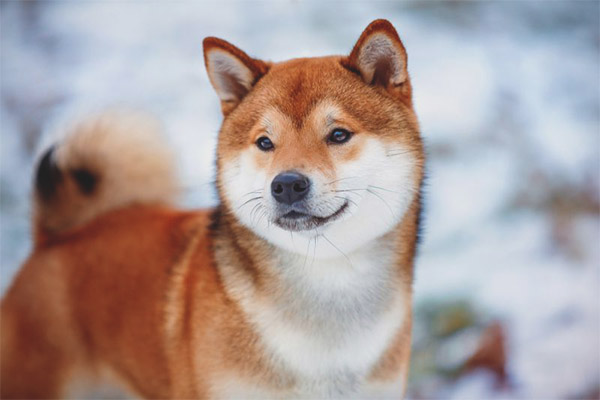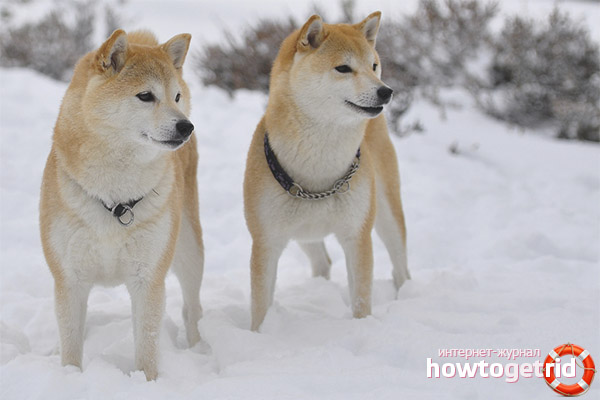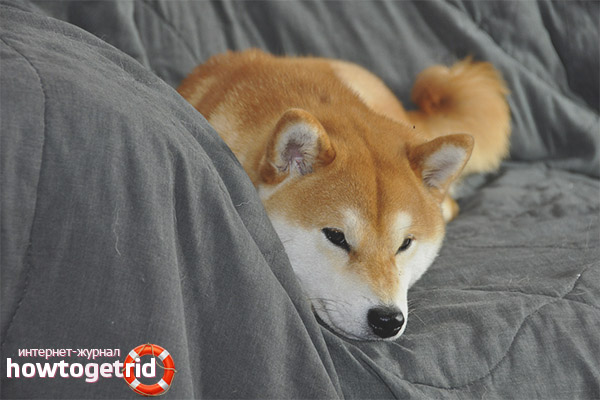The content of the article
Representatives of this breed, small dogs with appearance, something resembling a fox, come from Japan. Siba-inu or shiba-inu (as they are sometimes called because of the difficulty of pronunciation) are unique in that their unusually miniature size does not interfere with their excellent hunting skills. They are extremely popular among the Japanese and deservedly received recognition in other countries.
From the history of the breed
More than ten thousand years ago, the first settlements appeared in Japan. With them, they brought their pets, the remains of which were found in graves several thousand years BC. Presumably, these dogs are the ancient ancestors of the Shiba Inu.It is known that the ancestors of this breed arrived on the Japanese islands about 300 years BC. er with their masters come from Korea or China. They crossed their pets with local breeds. No one can say for sure which particular dogs are ancestors of the Siba-Inu, but it is known for certain that this breed is already several thousand years old. Presumably this breed was the result of the selection of larger Akita Inu.
These small dogs are found throughout Japan. They are small and picky in content compared to other breeds. Shiba Inu are great hunters, both in company with other relatives, and alone. Once they helped their owners catch bears and wild boars, as well as small game. At a time when firearms were not used on the hunt, these qualities were very much appreciated in dogs.
When such a weapon appeared, Siba Inu gained even greater popularity. They brought their owners small game after the shot. For a long time they were not isolated in a separate breed. These were dogs with similar instincts, with similarities in external data.
The very name of the breed comes from the Japanese "Inu" - "dog" and "Siba" - "bush", which can speak about the purpose of the pet for hunting purposes, when the dog makes an ambush in the bush. Another meaning of the word "small", which simply reflects the external characteristics of these pets.
For many years, Japan was considered a closed country. It was possible to guess what breeds of dogs are popular in this country. Acquaintance with Japanese culture began in the 54th year of the 19th century, when the borders of Japan were opened by the efforts of the American admiral Perry and his fleet.
Foreigners liked Japanese dogs so much that they brought them to their homeland, where these animals immediately gained popularity. Siba Inu in other countries began to cross with pointers and English setters. This led to the fact that the breed began to degenerate. Purebred specimens are preserved only in the Japanese provinces, where foreigners have not yet set foot.
At the beginning of the 20th century, Siba-Inu fans in Japan seriously thought about preserving the breed. In the 28th year of the same century, an organization called Nihon Ken Hozonkai was created by Dr. Hiro Saito, where her representatives were actively engaged in creating a standard for this breed. They found 6 typical species of Akita - Inu and actively engaged in their breeding.This breed of dog relished the representatives of the government and became a national symbol in the 31st year. The breed standards were approved in the 34th year of the 20th century, and a couple more years later they were recognized as a national breed. During the Second World War, the breeders had to put their pets to sleep, so the number of dogs decreased significantly. The surviving individuals were used to restore the breed at the end of hostilities. Breeders had to combine for this purpose all the remaining pedigree lines.
Before the Great World War began, there were several dozen variants of the Shiba-Inu breed, after which only 3 remained. They became the ancestors of the modern representatives of this breed. Shiba Inu in the new version quickly became popular in Japan. They recovered rapidly along with the economy of this country.
Residents of the cities preferred it to Siba-Inu - due to their small size, they quickly gained popularity. At the end of the 20th century, this breed became the most sought after in Japan.
It was thanks to the soldiers that Shiba Inu were brought to the United States. Over time, they gained popularity there due to their unusual appearance and similarity with foxes.In the 92nd year of the 20th century, the breed was recognized by the American Kennel Club and other reputable organizations.
Soon from the hunting breed, these dogs migrated into the category of companions. By the way, their hunting qualities have not gone away, they are very rarely used for their intended purpose.
Breed standards
Shiba Inu according to the classification of FCI refers to the primitive type of pomeranian. Companions and hunters are intended. Outwardly, they are small, harmoniously built animals with developed bones and muscles. They look beautiful and energetic, observant and lively. Their feature is the ratio of height and length of body 10:11.
Adults weigh from 8 to 13 kilograms in females and from 9 to 14 in males. Accordingly, growth in withers to 41.5 cm in males and not more than 38.5 in females.
- Torso Strong and muscular. Chest well developed. The stomach does not protrude.
- Head. Reminds fox. Broad, in parts of the skull with well-pronounced cheekbones. The muzzle tapers towards the nose.
- Ears. Triangular shape. Small sizes. Raised and looking forward.
- Paws. Fingers tightly assembled, bulging. Smooth. With moderately inclined shoulder blades. The hips are long and the shins are shorter.
- Neck. Muscular Middle length.
- Tail. Well pubescent. Set on high.Its length reaches the hock. It has a ring-shaped or sickle-shaped form.
- Wool. Ostev hair straight and hard, differing in density and density. The length is average. With a soft, tightly stuffed undercoat.
- Colors. Gold; gold with black; golden with silver tan. The brighter the ginger shade, the better.
The urahiro pattern is considered the most valuable: the lightest color of wool in the cheekbones, throat, in the lower part of the neck, chest, abdomen, paw pads.
Character traits
The nature of the representatives of this breed is due to their natural instincts. They are quite independent and somewhat similar to cats. Without proper upbringing and training can be quite aggressive and problematic. They are capable of independent decision-making and usually do at their own discretion. They like to be in the company, but at the same time have their own personal space.
Despite its diminutiveness and compactness, Siba-Inu have a stubborn and self-willed character, which creates some difficulties in the content, when mutual understanding with the owner is poorly adjusted. Of all family members, they, as a rule, choose their pet to whom they give up their love and reverence, and with all the rest they keep their distance. They do not differ in gullibility to strangers.They can relate to them with restraint and completely calmly, but without special contact.
They are very active and energetic, brave and hardy. But they like to receive attention and affection from their master. New people in the environment cause them some temporary alertness. Their sense of ownership is manifested in everything from personal toys to space.
With children of school age they get along just fine. Siby love to play, and quite cunning. In children they see allies for their pranks. But, if there are very little kids in the house, then it is worth limiting their communication with the dog. An animal may not like obsessive attention from a small child.
With other pets
Shiba Inu, as a rule, do not get along well on the same territory with other smaller brothers. However, there are exceptions if another pet appeared earlier than a representative of this breed. As for cats and rodents, then, taking into account the hunting instincts of Siba-inu, keeping them together is strictly prohibited.
Upbringing
To raise an active and wayward animal is necessary, starting from the earliest possible age, from the moment of its appearance in the house.Pet must be socialized, it must be taught to adhere to certain rules.
Shiba Inu education requires some rigor on the part of the owner and sufficient determination. However, physical punishment and rudeness are simply unacceptable. It is unlikely that representatives of this breed will fall into apathy from resentment, but it may react with counter aggression. At the same time, you can not allow the dog in all senses to "sit on the head." It is worth noting that the Sibs are inclined to this. Mistakes in the behavior of the pet must be condemned with the change of intonation in the voice.
The manifestation of aggressive behavior of the dog also requires some correction. When you try to make an attack on the owner or members of the family, the child can be taught a lesson by lightly slapping a newspaper, but in no case by hand. Most likely, the pet will be offended, but for a long time he will remember that it is simply unacceptable to behave this way.
Peculiarities of care
Sibas are very neat animals, they like cats independently maintain hygiene. While walking, these dogs never climb into mud or puddles, and when they come home they clean their paws. However, even such a neat animal requires some care.
Combing
Combing long and thick pet hair is required at least 2 times a week.For this purpose, suitable brush with long and stiff bristles. The remains of wool must be removed with a wet towel or hand. During the spout, combing a pet is required more often, preferably daily.
Hygiene procedures
- Every six months or at least you can bathe your pet. Especially this procedure is shown during the spade, it will help get rid of the fallen out hair.
- Claws should be trimmed once or twice a month with a special nail clipper or by a specialist.
- Ears are carefully examined and rubbed once a week using a sponge or cotton pad.
- To prevent caries and tartar, you need to brush your teeth every 7-10 days. Do this with a special toothpaste and brush or cotton pad.
The walks
After eating, this is one of the most important conditions for the care of Shiba Inu. Long and interesting walks in the fresh air should be necessary, no matter what the weather is outside. These active pets need a lot of walking. Plus, they love to run. The ideal owner of a dog of this breed often rides a bicycle.Now he can ride, holding the animal by the leash. An alternative to such a pastime can only be that which corresponds to the intended purpose of the Sibov - hunting.
In no case can not descend Siba Inu on a walk with a leash in the city. Not only surrounding people and animals can suffer from this, but also the four-legged friend itself.
Nutrition
Siba can be fed with both special food and natural food. There are no strict restrictions and recommendations on nutrition. The only rule is that one should not give natural food and feed of industrial production in one feeding.
For a pet you need two, and preferably three separate bowls. 2 for food and 1 for water. After feeding, you need to wash the dishes so that no food remains in it. It is advisable to teach the animal to eat in one, specially designated place according to the established regime, otherwise the dog will turn into a pig.
Attention! Shiba Inu have a tendency to individual reactions to certain foods, so you should not conduct food experiments on dogs of this breed.
The diet of an adult should necessarily include the following foods:
- Any meat, with the exception of fatty varieties in raw or boiled form.
- Sea fish without bones, heat treated.
- Cereals: rice, semolina, buckwheat.
- Dairy products.
- Boiled eggs.
- Vegetables: beets, cabbage, zucchini, carrots, pumpkin.
- Vegetable oils.
- Vitamin - mineral complexes.
Health and life expectancy
Often, Shiba Inu are distinguished by good enough health and have a life expectancy of 12 to 15 years.
There are individuals that suffer from the following congenital pathologies:
- Hip dysplasia.
- Prone to allergic reactions.
- Diseases of the organs of vision.
- Dislocation of knee cups.
- Hypothyroidism.
- Pseudohemophilia.
Owners of puppies need to timely visit the veterinarian and adhere to his recommendations, especially with regard to vaccinations. Kids Shiba Inu can become infected with unpleasant viral diseases, which often have a detrimental effect on their growing body:
- Hepatitis.
- Leptospirosis.
- Paragripp.
- Parvovirus enteritis.
Purchase
The kid must be healthy and active, playful, have a good appetite. Also during personal contact, the color of the animal and its pedigree data are clearly visible.
Before the acquisition, it is necessary to clearly define the place where the pet's main territory will be, to buy all the necessary things and toys for it.
The price of puppies depends on many factors that determine its value. A pet without documents will cost about $ 200. The price of a pet show class can reach 2000 US dollars and above.
Positive breed qualities
- Acute intelligence and daring.
- Endurance and energy.
- Good nature.
- Restraint and independence.
- Equilibrium.
Negative qualities of the breed
- Stubbornness and self-will.
- Propensity to manipulate.
- Sometimes aggressive behavior.
- It is highly undesirable to keep them with other pets in the house.
- They do not like to induce beauty: washing, mowing, and other procedures.
Dogs of this breed will suit active people who love walking and lead an active lifestyle. They will enthusiastically share picnics and romantic nature walks with their host. Siby - comrades, companions and defenders, have excellent protective qualities.
Video: Shiba Inu dog breed














To send